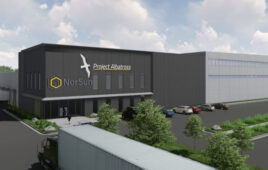Installing solar on existing structures is a common industry practice, however, the PV projects found on multilevel parking garages are unique in their sheer weight of materials and how they are installed. The planning, design and methods to installing carports — canopy structures composed of heavy steel foundations that can host long spans of solar modules — require some additional foresight and specialized machinery to properly mount to the concrete exteriors of parking garages.

Credit: M Bar C Construction
Solar carports are often found in parking lots where they provide renewable energy for the property owner and shading for commuters. This developed site does little more than organize vehicles. The same rationale applies to parking garages, but with added considerations for hauling or hoisting solar components multiple stories above the ground.
The array design differs between a parking lot and parking garage, because the latter can have ramps and other angled planes on its top section, and carport foundations will mount to concrete surfaces and not the ground or blacktop of a parking lot.
The common mounting foundation for these types of projects is an anchor bolt that is drilled and possibly epoxied into a base plate attached to a surface on the parking deck, be it the floor, stem wall or structural columns. Contractors core into the mounting surface with a concrete drill and clear the pilot hole of dust and debris before filling it with epoxy and driving in the anchor bolt through the base plate, which will hold the carport’s beam foundations.
“You’re using an all-thread [anchor], and it can be drilled anywhere from 1 ft into the existing pedestal, and I’ve seen as much as 2 and 3.5 ft,” said Bobby Bonfante, eastern division manager at M Bar C Construction, a turnkey carport manufacturer and installer. “You’re coring into this existing pedestal and there’s really tight tolerances and specifications for how you core it, how you clean it and how you place the epoxy and set the anchors.”
Determining if a parking deck is suited to host a solar carport requires approvals from structural engineers on both the building and the solar aspects of the project. During building inspection, it’s necessary to use specialized scanners to see what’s beneath the surface of the building. Solar carport manufacturer Quest Renewables does three different scans for a parking deck project: a laser scan, ground penetrating radar scan and a rebar scan, because “as-built” building plans do not always provide accurate schematics for interior supports like rebar.
“You really need to do your own forensics,” said Finn Findley, CEO of Quest Renewables.
Contractors can encounter degrading building conditions and might need to reinforce the structure with elements like metal saddle plates to strengthen mounting points.
“A big recommendation from us is doing a feasibility study,” Bonfanti said. “It’s a low-cost option to go through the existing plans, how we will connect a structure to the existing parking garage and then coming up with some preliminary sizing and details to help us understand the complexity and cost of the structure that we’re going to build.”

Credit: M Bar C Construction
Project timelines for solar carport projects on parking decks will likely be longer than those installed at ground level because they require additional coordination for handling the equipment and materials necessary to build them. Bonfanti said a 500-kW carport requires five to six truckloads for heavy steel and purlins, not including other components like solar modules. Then it’s a question of how to get those components to an elevated worksite.
If they’re unable to be taken by vehicle to the roof, components must be hoisted by crane, and the contractors must coordinate — and contend — with neighboring buildings, local traffic and the possibility that the garage owner wants to keep part of it in operation through construction. Then the heavy machinery used to move components might weigh too much to be on that worksite.
“There are calculations that you sometimes have to give to the original structural engineer to prove for the weight of the equipment that’s going up there,” Bonfanti said. “Sometimes you have to use the outriggers and platforms that disperse the load in a more spread-out fashion.”
Installing solar carports atop parking decks is a more specialized project than those found in parking lots, but this segment of the market is growing in popularity. Findley said about two-thirds of Quest Renewables’ individual projects are built on existing parking garages. They just require some more heavy lifting.
“I don’t want to scare anybody off, but, man, be prepared,” he said. “You really need to know what you’re doing, and if you don’t know what you’re doing, hire somebody who does, because it can be really difficult, really slow, and usually that means it’s also expensive, so we’re trying to help people avoid that.”





great thank you
would it be possible to know how the design part is conduced ?
what is the load case applied ?
are the structural code sufficient ? or do you need a wind tunnel study like for flat roof systems ?
thank you
Great article !